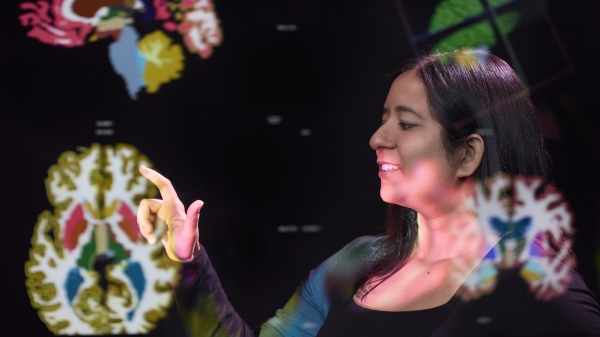Biology in motion: ASU professor awarded 2 Scialog Awards to fund research on advanced biological imaging

Douglas Shepherd, an assistant professor in Arizona State University’s Department of Physics, was recently awarded two Scialog Advanced Bioimaging awards that will fund two research projects using optics to visualize and quantify molecular biology in challenging settings.
Douglas Shepherd, an assistant professor in Arizona State University’s Department of Physics, was recently awarded two Scialog Advanced Bioimaging awards that will fund two research projects using optics to visualize and quantify molecular biology in challenging settings.
Shepherd is among 10 multidisciplinary research teams selected as part of the first year of Scialog: Advancing BioImaging, a three-year initiative supported by the Research Corporation for Science Advancement, the Chan Zuckerberg Initiative and the Frederick Gardner Cottrell Foundation, that aims to accelerate the development of the next generation of imaging technologies.
“We are incredibly proud of Dr. Shepherd for being selected as a recipient of two Scialog Advanced Bioimaging awards,” said Patricia Rankin, chair of the Department of Physics in The College of Liberal Arts and Sciences.
“The high impact work of the Shepherd Lab on developing and applying new bioimaging tools to understand biological regulation at the single-molecule level is a prime example of the innovation taking place within the Department of Physics and Center for Biological Physics. These well-deserved awards will enable Dr. Shepherd and his team to continue driving transformation and to innovate new ways to visualize biology in action.”
Two additional ASU faculty from the Ira A. Fulton Schools of Engineering, Barbara Smith and Benjamin Bartelle, were also selected as recipients of the award.
Shepherd’s first project, “4D molecular tracking using kilohertz framerate multimodal microscopy,” is funded by the Research Corporation for Science Advancement and will partner with Nick Galati, an assistant professor at Western Washington University in the Department of Biology and Shannon Quinn, an associate professor at the University of Georgia in the Department of Computer Science and the Department of Cellular Biology.
The interdisciplinary team will work to develop and benchmark a multimodal microscopy approach that enables single particle tracking within motile cilia. Motile cilia, or moving microscopic vibrating organelles found on the surface of certain cells, are found in human lungs, the respiratory tract and the middle ear. Among other functions, they work to clear our airways of mucus and dirt, allowing us to breathe more easily.
Motile cilia have been imaged before, however the dynamic processes that take place within them have only been investigated in artificially immobilized cilia — giving an incomplete understanding of a fundamental subcellular process that shapes human development. To give a more complete picture of motile cilia, the team will blend rapid quantitative phase imaging, fluorescence microscopy of individual cilia, and predictive particle tracking within the ciliary waveform.
“We might be able to understand how diseases actually change the physical motion of these microscopic hairlike structures in a way that nobody has ever understood before,” Shepherd said. “We need to be able to connect the fact that we see dysfunction to what is actually physically occurring on the cell. That is a current focus area in biomedical sciences, because as disease treatments become more targeted, we have to have finer and finer grain information available about exactly what's going on.”
His second project, “Wide-field, single-pixel fluorescence imaging with on-chip nanophotonics,” is funded by the Chan Zuckerberg Initiative and will partner with Lisa Poulikakos, an assistant professor at the University of California, San Diego in the Department of Mechanical and Aerospace Engineering.
Poulikakos and Shepherd aim to develop a unique approach to aberration and scatter-resistant microscopy that circumvents the limitations of traditional optics. Traditional fluorescence imaging methods are unable to form sharp images past 0.1 mm into tissue samples, because tissue scatters and absorbs light as it travels through the sample.
Researchers continue to create new methods to create sharp images as deep as a few millimeters into tissue samples. These scatter-resistant imaging methods are often significantly slower and require specialized lasers when compared to traditional methods, limiting their portability and adaptability. The team aims to simplify the experimental approach for scatter-resistant imaging by harnessing the power of a nanometer level fabrication and computational optics.
Using nanophotonics, the process of controlling light using materials patterned at the nanoscale, the team will create a lensless system that is capable of illuminating tissue samples using thousands of specifically designed patterns. The team will then design a computational framework that can decode a sharp image by extracting unique information from each pattern.
“Both of these awards center around interdisciplinary ideas on how to visualize and quantify molecular and cellular biology in unique and challenging situations where traditional approaches fail,” Shepherd said. “I am excited about the new collaborations established through Scialog and looking forward to exploring the boundaries with bioimaging with my fellow awardees."
In Shepherd’s Quantitative Imaging and Inference Lab, or QI2 Lab, he and his team of researchers are broadly interested in developing methods to study, understand and predict how cells make decisions during development. Five people in the QI2 Lab will contribute to the Scialog projects including one postdoctoral student, one professional research scientist and three graduate students.
The $50,000 award per project will support Shepherd’s research for one year. Depending on the outcome, he and his collaborators plan on applying for additional grants.
More Science and technology

How ASU is reshaping manufacturing training
The manufacturing sector faces a persistent challenge: a shortage of skilled workers.As industries adopt emerging technologies,…

Podcast explores the future in a rapidly evolving world
What will it mean to be human in the future? Who owns data and who owns us? Can machines think?These are some of the questions…

New NIH-funded program will train ASU students for the future of AI-powered medicine
The medical sector is increasingly exploring the use of artificial intelligence, or AI, to make health care more affordable and…